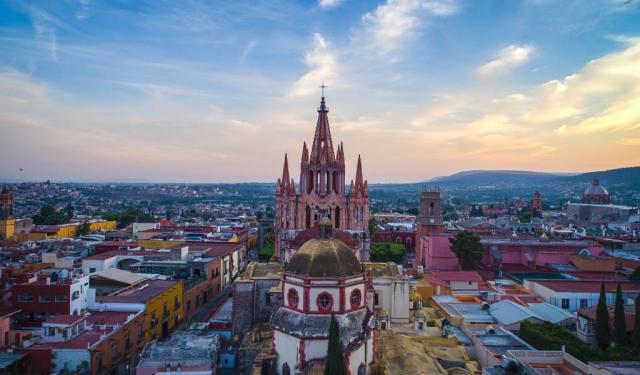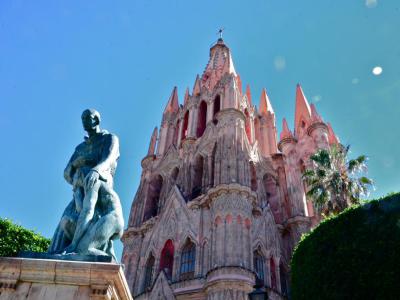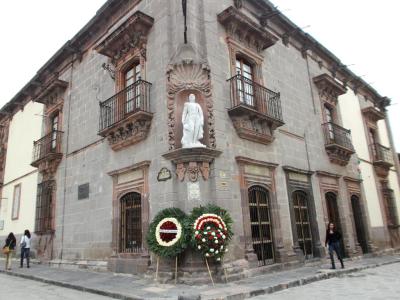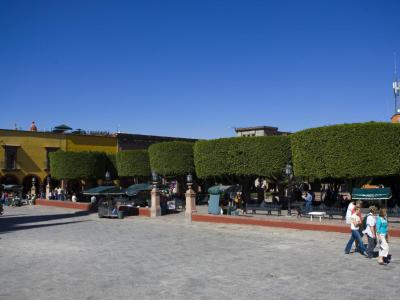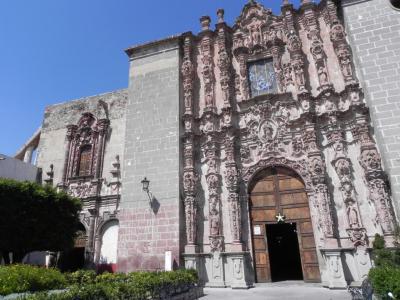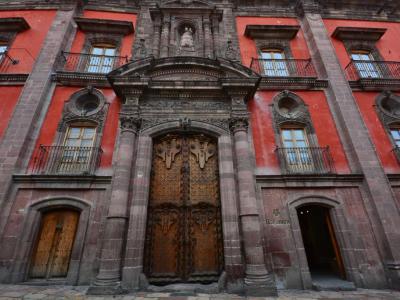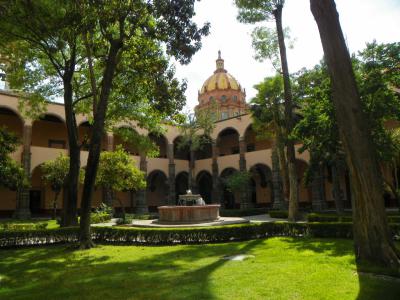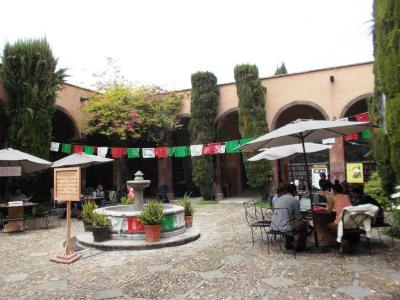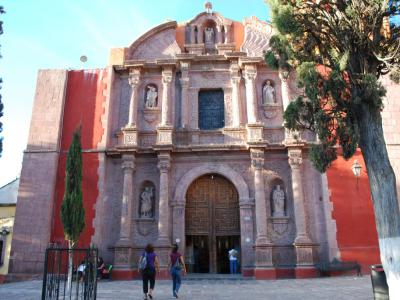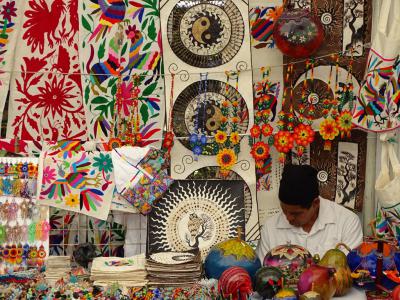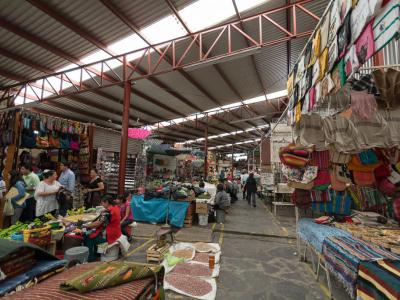San Miguel de Allende Introduction Walking Tour (Self Guided), San Miguel de Allende
They say San Miguel de Allende is like a perpetual work of art; everywhere you turn is a visual feast. Indeed, with its stunning colonial architecture, cobblestone streets, and undulating mountains, San Miguel de Allende is one of Mexico's most picturesque and beloved cities.
Its story began in the 16th century. Originally an indigenous village called Itzcuinapan, the settlement's transformation began in 1542 when Juan de San Miguel established a small chapel nearby, dedicating it to Archangel Michael. The town itself was originally known as "San Miguel el Grande," paying homage to the celestial guardian.
However, Spanish colonization led to conflicts with the natives, prompting the town's relocation to a more defensible site in 1555.
A new reincarnation of the old chapel, the Parish of San Miguel Archangel, a neoclassical marvel renowned for its elaborate facade with intricate carvings, appeared in the 17th century. Today, it serves as one of the standout attractions in the city.
Another significant spot is the Historical Museum of San Miguel de Allende. Inside, you can explore a captivating collection of artifacts that provide a glimpse into the lives of those who lived here in times gone by.
Throughout the colonial era, San Miguel thrived as a vital trading post along the silver route, reflecting both Spanish and indigenous influences in its culture. It played a role in Mexico's fight for independence, being the birthplace of figures like Ignacio Allende and Juan Aldama, pivotal in initiating the movement.
Plaza Allende is the heart of the city, a vibrant square that captures the essence of local life. The Church of San Francisco (Templo de San Francisco de Asis), in turn, is an emblem of spiritual devotion that graces the area with its architectural resplendence.
The city's fortunes fluctuated throughout the 19th century due to war and political strife, but its rich architectural heritage survived. In the 20th century, the city emerged as an artistic haven, attracting international artists and writers. The preservation of its colonial charm, coupled with its cultural vibrancy, led to UNESCO declaring San Miguel de Allende a World Heritage Site in 2008.
In the embrace of this remarkable destination, where the soul of Mexico finds its resplendent expression, history, and modernity coalesce, offering a tableau of allure that beckons the curious traveler. Don't miss the chance to experience this allure firsthand. Embark on this self-guided walk and uncover the beauty that awaits you.
Its story began in the 16th century. Originally an indigenous village called Itzcuinapan, the settlement's transformation began in 1542 when Juan de San Miguel established a small chapel nearby, dedicating it to Archangel Michael. The town itself was originally known as "San Miguel el Grande," paying homage to the celestial guardian.
However, Spanish colonization led to conflicts with the natives, prompting the town's relocation to a more defensible site in 1555.
A new reincarnation of the old chapel, the Parish of San Miguel Archangel, a neoclassical marvel renowned for its elaborate facade with intricate carvings, appeared in the 17th century. Today, it serves as one of the standout attractions in the city.
Another significant spot is the Historical Museum of San Miguel de Allende. Inside, you can explore a captivating collection of artifacts that provide a glimpse into the lives of those who lived here in times gone by.
Throughout the colonial era, San Miguel thrived as a vital trading post along the silver route, reflecting both Spanish and indigenous influences in its culture. It played a role in Mexico's fight for independence, being the birthplace of figures like Ignacio Allende and Juan Aldama, pivotal in initiating the movement.
Plaza Allende is the heart of the city, a vibrant square that captures the essence of local life. The Church of San Francisco (Templo de San Francisco de Asis), in turn, is an emblem of spiritual devotion that graces the area with its architectural resplendence.
The city's fortunes fluctuated throughout the 19th century due to war and political strife, but its rich architectural heritage survived. In the 20th century, the city emerged as an artistic haven, attracting international artists and writers. The preservation of its colonial charm, coupled with its cultural vibrancy, led to UNESCO declaring San Miguel de Allende a World Heritage Site in 2008.
In the embrace of this remarkable destination, where the soul of Mexico finds its resplendent expression, history, and modernity coalesce, offering a tableau of allure that beckons the curious traveler. Don't miss the chance to experience this allure firsthand. Embark on this self-guided walk and uncover the beauty that awaits you.
How it works: Download the app "GPSmyCity: Walks in 1K+ Cities" from Apple App Store or Google Play Store to your mobile phone or tablet. The app turns your mobile device into a personal tour guide and its built-in GPS navigation functions guide you from one tour stop to next. The app works offline, so no data plan is needed when traveling abroad.
San Miguel de Allende Introduction Walking Tour Map
Guide Name: San Miguel de Allende Introduction Walking Tour
Guide Location: Mexico » San Miguel de Allende (See other walking tours in San Miguel de Allende)
Guide Type: Self-guided Walking Tour (Sightseeing)
# of Attractions: 10
Tour Duration: 1 Hour(s)
Travel Distance: 1.5 Km or 0.9 Miles
Author: DanaOffice
Sight(s) Featured in This Guide:
Guide Location: Mexico » San Miguel de Allende (See other walking tours in San Miguel de Allende)
Guide Type: Self-guided Walking Tour (Sightseeing)
# of Attractions: 10
Tour Duration: 1 Hour(s)
Travel Distance: 1.5 Km or 0.9 Miles
Author: DanaOffice
Sight(s) Featured in This Guide:
- Parish of San Miguel Archangel
- Historical Museum of San Miguel de Allende
- Plaza Allende
- Templo de San Francisco de Asis (Church of San Francisco)
- Casa del Mayorazgo de Canal (House of the De La Canal Estate)
- Centro Cultural Ignacio Ramírez (Ignacio Ramirez Cultural Center)
- La Biblioteca Publica (Public Library)
- Oratorio de San Felipe Neri (Oratory of San Felipe Neri)
- Mercado de Artesanías (Artisan Market)
- Ignacio Ramírez Market
1) Parish of San Miguel Archangel (must see)
The Parish of San Miguel Archangel is widely recognized for its distinctive pink "wedding cake" towers that gracefully pierce the sky, adding an enchanting allure to the town's skyline. This architectural wonder serves as a testament to the creativity and craftsmanship of indigenous stonemason Zeferino Gutiérrez, who left an indelible mark on the late 19th century design.
The story behind the creation of these peculiar pinnacles only adds to the church's mystique. Zeferino Gutiérrez reportedly drew inspiration from a postcard featuring a Belgian church, using it as a blueprint for his innovative design. Intriguingly, he communicated his vision to builders by etching plans in the sand with a simple stick.
While the towers may be the most visually striking elements, the rest of the church carries its own historical significance. Dating back to the late 17th century, the remaining structure exudes a sense of history and timelessness. As visitors step into this sacred space, they are transported to an era of devotion and architectural mastery.
Within the hallowed walls of the church, a hidden treasure awaits in the form of a revered image – the Christ of the Conquest. Crafted from the humblest of materials, cornstalks and orchid bulbs, this image holds a profound spiritual significance. Its origins trace back to Pátzcuaro, potentially dating back to the 16th century.
Adjacent to this revered image is the Saint Raphael Church, a complementary edifice founded in 1742. Together, these structures form a spiritual complex that invites both reflection and admiration.
The story behind the creation of these peculiar pinnacles only adds to the church's mystique. Zeferino Gutiérrez reportedly drew inspiration from a postcard featuring a Belgian church, using it as a blueprint for his innovative design. Intriguingly, he communicated his vision to builders by etching plans in the sand with a simple stick.
While the towers may be the most visually striking elements, the rest of the church carries its own historical significance. Dating back to the late 17th century, the remaining structure exudes a sense of history and timelessness. As visitors step into this sacred space, they are transported to an era of devotion and architectural mastery.
Within the hallowed walls of the church, a hidden treasure awaits in the form of a revered image – the Christ of the Conquest. Crafted from the humblest of materials, cornstalks and orchid bulbs, this image holds a profound spiritual significance. Its origins trace back to Pátzcuaro, potentially dating back to the 16th century.
Adjacent to this revered image is the Saint Raphael Church, a complementary edifice founded in 1742. Together, these structures form a spiritual complex that invites both reflection and admiration.
2) Historical Museum of San Miguel de Allende (must see)
The Museo Histórico Casa de Allende stands as a timeless testament to history, courage, and the enduring spirit of Mexico. Its story began in 1760 when Domingo Narciso de Allende y Ayerdi laid the foundation stones of what would become a cornerstone of Mexican heritage. A year later, this stately abode was gifted as a wedding present to María Josefa de Unzaga, forming the ancestral cradle of the Unzaga-Allende family, with Ignacio Allende, a revered hero of Mexico's independence, as one of its illustrious offspring.
The Museo Histórico Casa de Allende's façade, an artistic mélange of asymmetrical elegance, boasts a baroque entrance adorned with neoclassical nuances. Wrought iron flourishes grace the balconies and bars, showcasing intricate designs that pay homage to the craftsmanship of eras bygone.
The ground floor's inaugural room delves into the geological heritage of the region, tracing its evolution from the Pliocene era. Pre-Hispanic legacies and the inception of settlements in the Laja river basin unfold within these walls. Ascending to the upper floor, the exhibits delve into the legacy of San Miguel in the New Hispanic era – a tapestry woven with threads of commerce, culture, education, and the formation of militias.
Yet, the soul of the museum rests in its connection to Ignacio Allende. On the ground floor, amidst these hallowed halls, the story of this iconic figure comes to life. Each room, each exhibit, is a tribute to his enduring influence and the mark he left on Mexico's path to independence.
The Museo Histórico Casa de Allende's façade, an artistic mélange of asymmetrical elegance, boasts a baroque entrance adorned with neoclassical nuances. Wrought iron flourishes grace the balconies and bars, showcasing intricate designs that pay homage to the craftsmanship of eras bygone.
The ground floor's inaugural room delves into the geological heritage of the region, tracing its evolution from the Pliocene era. Pre-Hispanic legacies and the inception of settlements in the Laja river basin unfold within these walls. Ascending to the upper floor, the exhibits delve into the legacy of San Miguel in the New Hispanic era – a tapestry woven with threads of commerce, culture, education, and the formation of militias.
Yet, the soul of the museum rests in its connection to Ignacio Allende. On the ground floor, amidst these hallowed halls, the story of this iconic figure comes to life. Each room, each exhibit, is a tribute to his enduring influence and the mark he left on Mexico's path to independence.
3) Plaza Allende (must see)
Plaza Allende , often referred to as the Zocalo, is the vibrant heart of San Miguel de Allende. Nestled within the historic city, this main plaza exudes an irresistible charm that draws both locals and visitors alike. The plaza serves as a focal point where people converge to enjoy a myriad of experiences that capture the essence of this enchanting town. The plaza is popularly known as The Main Garden, or just The Garden.
As you step into Plaza Allende, you'll find yourself enveloped in an atmosphere of lively activity and cultural richness. The plaza's central location makes it an ideal spot for people-watching, an art that comes to life as you observe the tapestry of lives passing by. The surrounding shops and restaurants offer a captivating mix of traditional Mexican craftsmanship and modern culinary delights, making it a perfect spot for leisurely exploration.
San Miguel de Allende's winding streets can sometimes lead the wanderer astray, but The Graden acts as a welcoming landmark, a sanctuary of orientation amidst the labyrinthine roads. The plaza beckons you to pause, recalibrate, and soak in the surroundings before continuing your journey through this charming town.
The plaza's allure is not just in its physical beauty, but in the experiences it hosts. Depending on the time you find yourself in The Graden, you might be fortunate enough to witness a political rally, immerse yourself in the rhythms of a live concert, or partake in the festivities of a local celebration. Mariachi bands serenade the air, dance performances grace the cobblestones, and artisans showcase their crafts, painting a vivid mosaic of culture.
The enchanting energy of El Jardín is particularly pronounced during early evenings and weekend afternoons. As the sun begins to set, the plaza comes alive with a vibrant tapestry of expats and locals. Wrought-iron benches become meeting points for friends catching up or individuals simply savoring the tranquil ambiance.
As you step into Plaza Allende, you'll find yourself enveloped in an atmosphere of lively activity and cultural richness. The plaza's central location makes it an ideal spot for people-watching, an art that comes to life as you observe the tapestry of lives passing by. The surrounding shops and restaurants offer a captivating mix of traditional Mexican craftsmanship and modern culinary delights, making it a perfect spot for leisurely exploration.
San Miguel de Allende's winding streets can sometimes lead the wanderer astray, but The Graden acts as a welcoming landmark, a sanctuary of orientation amidst the labyrinthine roads. The plaza beckons you to pause, recalibrate, and soak in the surroundings before continuing your journey through this charming town.
The plaza's allure is not just in its physical beauty, but in the experiences it hosts. Depending on the time you find yourself in The Graden, you might be fortunate enough to witness a political rally, immerse yourself in the rhythms of a live concert, or partake in the festivities of a local celebration. Mariachi bands serenade the air, dance performances grace the cobblestones, and artisans showcase their crafts, painting a vivid mosaic of culture.
The enchanting energy of El Jardín is particularly pronounced during early evenings and weekend afternoons. As the sun begins to set, the plaza comes alive with a vibrant tapestry of expats and locals. Wrought-iron benches become meeting points for friends catching up or individuals simply savoring the tranquil ambiance.
4) Templo de San Francisco de Asis (Church of San Francisco) (must see)
The Church of San Francisco stands as a testament to the artistry and devotion that define both the architecture of a bygone era and the spiritual heart of a community. This iconic church boasts one of Guanajuato State's most exquisite churrigueresque facades, a style that finds its inspiration in the extravagant surface embellishments pioneered by the renowned Spanish architect José Churriguera during the 17th century baroque period.
Erected in the latter part of the 18th century, the Church of San Francisco is more than just a place of worship; it is a masterpiece forged by the contributions of the faithful and the revenues from bullfights, a testament to the fusion of diverse influences that have left an indelible mark on its structure. The exterior stands as a visual symphony of intricate carvings, ornate details, and a harmonious blend of artistic elements. Crowning this architectural marvel is the resplendent image of Saint Francis of Assisi, a homage to the patron saint and a testament to the devotion that animated the construction.
Beneath the watchful gaze of Saint Francis, a tableau of limestone sculptures graces the facade. Dozens of angels, saints, and Franciscan friars emerge from the stone, capturing a moment frozen in time, an ensemble that speaks to the connection between the divine and the earthly. As the sun casts its golden hues upon the facade, these sculpted figures come to life, their stories intertwined with the history of San Miguel de Allende.
However, the contrasts that make the Church of San Francisco truly enchanting emerge as you cross its threshold. While the exterior exudes opulence and intricacy, the interior exudes a sense of serene simplicity. Within these hallowed walls, the starkness of the interior serves as a canvas upon which the faithful can project their thoughts and prayers. The unadorned walls and unembellished ceilings invite contemplation, offering a space for personal reflection amidst the grandeur of the external world.
Erected in the latter part of the 18th century, the Church of San Francisco is more than just a place of worship; it is a masterpiece forged by the contributions of the faithful and the revenues from bullfights, a testament to the fusion of diverse influences that have left an indelible mark on its structure. The exterior stands as a visual symphony of intricate carvings, ornate details, and a harmonious blend of artistic elements. Crowning this architectural marvel is the resplendent image of Saint Francis of Assisi, a homage to the patron saint and a testament to the devotion that animated the construction.
Beneath the watchful gaze of Saint Francis, a tableau of limestone sculptures graces the facade. Dozens of angels, saints, and Franciscan friars emerge from the stone, capturing a moment frozen in time, an ensemble that speaks to the connection between the divine and the earthly. As the sun casts its golden hues upon the facade, these sculpted figures come to life, their stories intertwined with the history of San Miguel de Allende.
However, the contrasts that make the Church of San Francisco truly enchanting emerge as you cross its threshold. While the exterior exudes opulence and intricacy, the interior exudes a sense of serene simplicity. Within these hallowed walls, the starkness of the interior serves as a canvas upon which the faithful can project their thoughts and prayers. The unadorned walls and unembellished ceilings invite contemplation, offering a space for personal reflection amidst the grandeur of the external world.
5) Casa del Mayorazgo de Canal (House of the De La Canal Estate)
House of the De La Canal Estate bears witness to the opulence and influence of the De La Canal family, who once called this architectural masterpiece their home.
As you approach the House of the De La Canal Estate, your gaze is immediately drawn to its monumental carved wooden main door, a testament to both the skill of colonial craftsmen and the esteemed status of the family.
The grandeur of this mansion is a reflection of the family's social and economic stature in New Spain. The De La Canal family was among the wealthiest and most influential families of their time, and their residence reflects their standing in the society.
Though this historic residence has transitioned through the hands of time, it remains a testament to the past. Today, the House of the De La Canal Estate houses a branch of the National Bank of Mexico.
The story within these walls doesn't end with banking. The Casa de Cultura de Banamex, or the Banamex Cultural Center, has found its home within this historic building. Within its hallowed halls, a collection of historic paintings whispers tales of a bygone era, bringing to life the culture, art, and spirit of the past. The center also serves as a venue for special art exhibitions, a space where the creativity of the present converges with the rich history of the past.
As you approach the House of the De La Canal Estate, your gaze is immediately drawn to its monumental carved wooden main door, a testament to both the skill of colonial craftsmen and the esteemed status of the family.
The grandeur of this mansion is a reflection of the family's social and economic stature in New Spain. The De La Canal family was among the wealthiest and most influential families of their time, and their residence reflects their standing in the society.
Though this historic residence has transitioned through the hands of time, it remains a testament to the past. Today, the House of the De La Canal Estate houses a branch of the National Bank of Mexico.
The story within these walls doesn't end with banking. The Casa de Cultura de Banamex, or the Banamex Cultural Center, has found its home within this historic building. Within its hallowed halls, a collection of historic paintings whispers tales of a bygone era, bringing to life the culture, art, and spirit of the past. The center also serves as a venue for special art exhibitions, a space where the creativity of the present converges with the rich history of the past.
6) Centro Cultural Ignacio Ramírez (Ignacio Ramirez Cultural Center)
The Ignacio Ramírez Cultural Center emerges as a captivating haven for art, education, and the vibrant spirit of creativity. Housed within the walls of the former Conception Convent, a structure that dates back to 1755, this cultural sanctuary beckons just two blocks west of the iconic The Garden, the heart of the city. Operating as a branch of the esteemed Palace of Fine Arts in Mexico City, the Ignacio Ramírez Cultural Center unfolds as a testament to the city's commitment to nurturing artistic expression and cultural exploration.
This architectural marvel envelopes an expansive courtyard adorned with stately trees that cast dappled shadows and a soothing gurgling fountain that sings its song of tranquility. It's here, within these ancient walls and serene surroundings, that art finds its sanctuary.
The classrooms that line the cloister's pathways are spaces of transformation, where drawing, painting, sculpture, lithography, textiles, ceramics, dramatic arts, ballet, regional dance, piano, and guitar come alive through the guidance of skilled instructors.
As you explore the center's expanse, the presence of history intertwines with contemporary expression. A mural by the renowned artist David Alfaro Siqueiros graces the walls, a testament to his creative legacy and the enduring impact of his work. This homage to artistic vision is enriched by a collection of memorabilia that offers insights into the artist's life and journey.
Among the treasures of the Ignacio Ramírez Cultural Center lies a haven for sustenance and relaxation. The restaurant Las Musas, nestled within these enchanting surroundings, welcomes you to dine amidst beauty and creativity.
Before bidding adieu to this cultural haven, cast your gaze towards the magnificent dome that graces the convent. This awe-inspiring architectural wonder belongs to the Iglesia de la Concepción, designed by the same unschooled architect who crafted the iconic La Parroquia.
This architectural marvel envelopes an expansive courtyard adorned with stately trees that cast dappled shadows and a soothing gurgling fountain that sings its song of tranquility. It's here, within these ancient walls and serene surroundings, that art finds its sanctuary.
The classrooms that line the cloister's pathways are spaces of transformation, where drawing, painting, sculpture, lithography, textiles, ceramics, dramatic arts, ballet, regional dance, piano, and guitar come alive through the guidance of skilled instructors.
As you explore the center's expanse, the presence of history intertwines with contemporary expression. A mural by the renowned artist David Alfaro Siqueiros graces the walls, a testament to his creative legacy and the enduring impact of his work. This homage to artistic vision is enriched by a collection of memorabilia that offers insights into the artist's life and journey.
Among the treasures of the Ignacio Ramírez Cultural Center lies a haven for sustenance and relaxation. The restaurant Las Musas, nestled within these enchanting surroundings, welcomes you to dine amidst beauty and creativity.
Before bidding adieu to this cultural haven, cast your gaze towards the magnificent dome that graces the convent. This awe-inspiring architectural wonder belongs to the Iglesia de la Concepción, designed by the same unschooled architect who crafted the iconic La Parroquia.
7) La Biblioteca Publica (Public Library)
Nestled amidst the charming streets of San Miguel de Allende, the city's Public Library stands as a hidden gem that beckons to those seeking both respite and enrichment. While libraries might not typically make it onto your vacation checklist, the San Miguel Public Library proves itself a destination worth reconsidering.
Stepping into the library, you'll immediately sense an air of tranquility that stands in delightful contrast to the bustling sights and sounds of the city. The library is more than just a repository of books; it's a sanctuary for the mind and spirit. Its expansive collection spans the realms of both Spanish and English, offering a diverse range of books and films that cater to the curiosity of every visitor.
The origins of this cultural haven trace back to the 1950s when Canadian expat Helen Wale extended a heartfelt invitation to Mexican children to explore a modest collection of magazines within the confines of her home. The enthusiasm of young readers quickly outgrew the confines of her space, and in 1958, the library found its home within an elegant 18th-century building several blocks north of El Jardin, the heart of San Miguel.
The library also emerges as a cultural epicenter by hosting a medley of events, including art exhibitions, lectures, and English-language tours that lead visitors through the labyrinthine streets, unveiling the storied colonial architecture that graces the neighborhood.
Within its embrace, a courtyard café provides a delightful space to savor a quick bite while surrounded by the soothing ambiance of the library's atmosphere. Moreover, the Santa Ana Theatre, nestled within the library's walls, opens its doors to showcase international films and host captivating concerts by San Miguel's beloved musicians.
Stepping into the library, you'll immediately sense an air of tranquility that stands in delightful contrast to the bustling sights and sounds of the city. The library is more than just a repository of books; it's a sanctuary for the mind and spirit. Its expansive collection spans the realms of both Spanish and English, offering a diverse range of books and films that cater to the curiosity of every visitor.
The origins of this cultural haven trace back to the 1950s when Canadian expat Helen Wale extended a heartfelt invitation to Mexican children to explore a modest collection of magazines within the confines of her home. The enthusiasm of young readers quickly outgrew the confines of her space, and in 1958, the library found its home within an elegant 18th-century building several blocks north of El Jardin, the heart of San Miguel.
The library also emerges as a cultural epicenter by hosting a medley of events, including art exhibitions, lectures, and English-language tours that lead visitors through the labyrinthine streets, unveiling the storied colonial architecture that graces the neighborhood.
Within its embrace, a courtyard café provides a delightful space to savor a quick bite while surrounded by the soothing ambiance of the library's atmosphere. Moreover, the Santa Ana Theatre, nestled within the library's walls, opens its doors to showcase international films and host captivating concerts by San Miguel's beloved musicians.
8) Oratorio de San Felipe Neri (Oratory of San Felipe Neri)
The Oratory of San Felipe Neri is adorned with multiple towers and crowned with a graceful dome, emanates the echoes of the 18th century, capturing the essence of a bygone era. The pale-pink facade of the Oratory of San Felipe Neri is a masterpiece of baroque architecture imbued with an indigenous aesthetic. The intricate detailing reflects a harmonious fusion of artistic styles, a visual symphony that draws the eye and the spirit into its embrace.
A passageway to the right of this facade unveils a hidden passage to the church's eastern wall. Here, a doorway proudly holds the image of Nuestra Señora de la Soledad, the embodiment of Our Lady of Solitude. This subtle yet powerful representation offers a glimpse into the spiritual depth that resonates within these walls.
As you step through the threshold, the church's interior unfurls an exquisite narrative. Thirty-three oil paintings grace the walls, recounting scenes from the life of San Felipe Neri, the 16th-century visionary who established the Oratorio Catholic order.
Within the east transept, a masterpiece painted by the celebrated colonial artist Miguel Cabrera adorns the sanctuary. This painting, depicting the Virgin of Guadalupe, stands as a tribute to both artistic mastery and religious devotion, an emblem of the spiritual significance that the Oratory holds within its confines.
In the opposite west transept, a lavishly adorned chapel graces the space. This 1735 chapel, known as the Santa Casa de Loreto, is a replica of a chapel in Loreto, Italy-an esteemed landmark said to be the legendary home of the Virgin Mary. This replica not only honors the Italian heritage but also resonates with the profound reverence for the divine that has touched the hearts of many.
Amidst the grandeur and history, a hidden treasure lies within the camarín-the chapel located behind the main church. This sacred space boasts six elaborately gilded baroque altars, each a masterpiece in its own right. One of these altars houses a reclining wax figure of San Columbano, believed to contain the saint's very bones. This chapel becomes a place of quiet contemplation, an intimate connection to the sacred stories that have shaped the fabric of faith.
A passageway to the right of this facade unveils a hidden passage to the church's eastern wall. Here, a doorway proudly holds the image of Nuestra Señora de la Soledad, the embodiment of Our Lady of Solitude. This subtle yet powerful representation offers a glimpse into the spiritual depth that resonates within these walls.
As you step through the threshold, the church's interior unfurls an exquisite narrative. Thirty-three oil paintings grace the walls, recounting scenes from the life of San Felipe Neri, the 16th-century visionary who established the Oratorio Catholic order.
Within the east transept, a masterpiece painted by the celebrated colonial artist Miguel Cabrera adorns the sanctuary. This painting, depicting the Virgin of Guadalupe, stands as a tribute to both artistic mastery and religious devotion, an emblem of the spiritual significance that the Oratory holds within its confines.
In the opposite west transept, a lavishly adorned chapel graces the space. This 1735 chapel, known as the Santa Casa de Loreto, is a replica of a chapel in Loreto, Italy-an esteemed landmark said to be the legendary home of the Virgin Mary. This replica not only honors the Italian heritage but also resonates with the profound reverence for the divine that has touched the hearts of many.
Amidst the grandeur and history, a hidden treasure lies within the camarín-the chapel located behind the main church. This sacred space boasts six elaborately gilded baroque altars, each a masterpiece in its own right. One of these altars houses a reclining wax figure of San Columbano, believed to contain the saint's very bones. This chapel becomes a place of quiet contemplation, an intimate connection to the sacred stories that have shaped the fabric of faith.
9) Mercado de Artesanías (Artisan Market)
The Artisan Market is a dynamic celebration of the region's rich artistic heritage and creative spirit. This market is not merely a collection of stalls; it's a living testament to the ingenuity and craftsmanship of local artisans, a place where the essence of San Miguel's artistic soul is brought to life through a dazzling array of handcrafted treasures.
As you step into the Artisan Market, a symphony of colors, textures, and forms welcomes you. The market showcases the intricate handiwork of local artisans who pour their heart and soul into their creations. The diverse array of materials ranges from brass to wool, quarry to mesquite wood carving, papier-mâché to glass, goldsmithing to ceramics. Among these artisanal treasures, you'll also find precious stones and antique relics that whisper stories of the past. The market sprawls across three bustling blocks, each stall an open window into the world of craftsmanship, where it's nearly impossible to resist leaving without a piece of this artistic tapestry.
Embrace the opportunity to witness firsthand the labor of love that goes into each creation. The prices, reflective of the skill and dedication invested in these pieces, are reasonable and well worth the value they hold.
From hand-carved mesquite wood sculptures to intricately designed jewelry, each stall unveils a treasure trove of unique offerings. Local stones like Mexican jade find new life as pendants and rings, while hand-painted ceramics and vibrant Oaxacan rugs add splashes of color and tradition. Even the souvenirs are transformed into artistic masterpieces, hand-painted with care.
The Artisan Market is not just a marketplace; it's a sensory experience. Wander through its covered expanse, where the air is laced with the aroma of local honey, handmade sweets, and medicinal herbs.
As you step into the Artisan Market, a symphony of colors, textures, and forms welcomes you. The market showcases the intricate handiwork of local artisans who pour their heart and soul into their creations. The diverse array of materials ranges from brass to wool, quarry to mesquite wood carving, papier-mâché to glass, goldsmithing to ceramics. Among these artisanal treasures, you'll also find precious stones and antique relics that whisper stories of the past. The market sprawls across three bustling blocks, each stall an open window into the world of craftsmanship, where it's nearly impossible to resist leaving without a piece of this artistic tapestry.
Embrace the opportunity to witness firsthand the labor of love that goes into each creation. The prices, reflective of the skill and dedication invested in these pieces, are reasonable and well worth the value they hold.
From hand-carved mesquite wood sculptures to intricately designed jewelry, each stall unveils a treasure trove of unique offerings. Local stones like Mexican jade find new life as pendants and rings, while hand-painted ceramics and vibrant Oaxacan rugs add splashes of color and tradition. Even the souvenirs are transformed into artistic masterpieces, hand-painted with care.
The Artisan Market is not just a marketplace; it's a sensory experience. Wander through its covered expanse, where the air is laced with the aroma of local honey, handmade sweets, and medicinal herbs.
10) Ignacio Ramírez Market
Nestled just a leisurely 3-minute stroll away from El Jardin, the pulsating heart of San Miguel de Allende, the Ignacio Ramírez Market emerges as a vibrant tapestry woven from the threads of daily life and local commerce. As you step into this bustling marketplace, you're immediately enveloped in a sensory symphony that encapsulates the essence of this Mexican town.
The market's aisles unfold before you, each offering a tableau of life's necessities and treasures. Here, vegetables and fruits lay nestled beside vibrant flowers, their colors mirroring the lively spirit of the market itself. The air is alive with the aroma of freshly cut produce and the sounds of friendly exchanges as locals and visitors engage in spirited bargaining. Wander deeper, and you'll discover a mosaic of assorted wares, from shoes to keys, each item contributing to the vibrant tapestry of everyday existence.
Pause for a moment to savor the offerings. Perhaps a cup of fresh juice tempts your palate, or an inexpensive lunch invites you to experience the local flavors. As you navigate the market's labyrinthine pathways, a sense of authenticity pervades the atmosphere, reminding you that you're not just a visitor but a witness to the heartbeat of San Miguel's daily life.
Venture further into the market, and you'll uncover an unexpected treasure trove. Pinatas hang suspended, their vibrant hues adding an air of festivity to the surroundings. Immerse yourself in the sensory delights of the market: the scent of flowers, the hum of conversations, and the vivid colors that bring the scene to life. This is more than just a market; it's a gateway to the soul of San Miguel, a place where culture and commerce intertwine.
The market's aisles unfold before you, each offering a tableau of life's necessities and treasures. Here, vegetables and fruits lay nestled beside vibrant flowers, their colors mirroring the lively spirit of the market itself. The air is alive with the aroma of freshly cut produce and the sounds of friendly exchanges as locals and visitors engage in spirited bargaining. Wander deeper, and you'll discover a mosaic of assorted wares, from shoes to keys, each item contributing to the vibrant tapestry of everyday existence.
Pause for a moment to savor the offerings. Perhaps a cup of fresh juice tempts your palate, or an inexpensive lunch invites you to experience the local flavors. As you navigate the market's labyrinthine pathways, a sense of authenticity pervades the atmosphere, reminding you that you're not just a visitor but a witness to the heartbeat of San Miguel's daily life.
Venture further into the market, and you'll uncover an unexpected treasure trove. Pinatas hang suspended, their vibrant hues adding an air of festivity to the surroundings. Immerse yourself in the sensory delights of the market: the scent of flowers, the hum of conversations, and the vivid colors that bring the scene to life. This is more than just a market; it's a gateway to the soul of San Miguel, a place where culture and commerce intertwine.
The Most Popular Cities
/ view all
